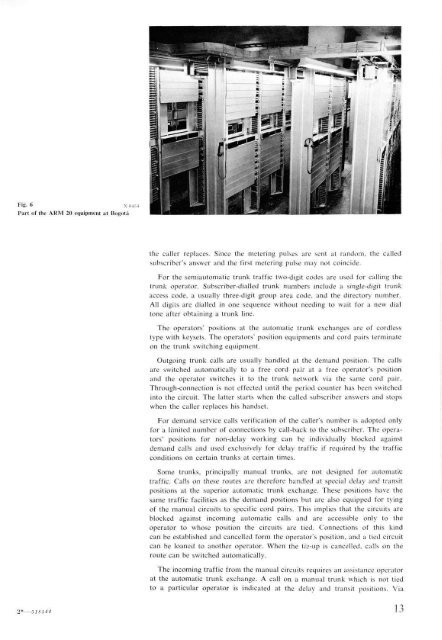1 - History of Ericsson - History of Ericsson
1 - History of Ericsson - History of Ericsson
1 - History of Ericsson - History of Ericsson
You also want an ePaper? Increase the reach of your titles
YUMPU automatically turns print PDFs into web optimized ePapers that Google loves.
Fig. 6 X 8454<br />
Part <strong>of</strong> the ARM 20 equipment at Bogota<br />
-31S544<br />
the caller replaces. Since the metering pulses are sent at random, the called<br />
subscriber's answer and the first metering pulse may not coincide.<br />
For the semiautomatic trunk traffic two-digit codes are used for calling the<br />
trunk operator. Subscriber-dialled trunk numbers include a single-digit trunk<br />
access code, a usually three-digit group area code, and the directory number.<br />
All digits are dialled in one sequence without needing to wait for a new dial<br />
tone after obtaining a trunk line.<br />
The operators' positions at the automatic trunk exchanges are <strong>of</strong> cordless<br />
type with keysets. The operators' position equipments and cord pairs terminate<br />
on the trunk switching equipment.<br />
Outgoing trunk calls are usually handled at the demand position. The calls<br />
are switched automatically to a free cord pair at a free operator's position<br />
and the operator switches it to the trunk network via the same cord pair.<br />
Through-connection is not effected until the period counter has been switched<br />
into the circuit. The latter starts when the called subscriber answers and stops<br />
when the caller replaces his handset.<br />
For demand service calls verification <strong>of</strong> the caller's number is adopted only<br />
for a li'mited number <strong>of</strong> connections by call-back to the subscriber. The operators'<br />
positions for non-delay working can be individually blocked against<br />
demand calls and used exclusively for delay traffic if required by the traffic<br />
conditions on certain trunks at certain times.<br />
Some trunks, principally manual trunks, are not designed for automatic<br />
traffic. Calls on these routes are therefore handled at special delay and transit<br />
positions at the superior automatic trunk exchange. These positions have the<br />
same traffic facilities as the demand positions but are also equipped for tying<br />
<strong>of</strong> the manual circuits to specific cord pairs. This implies that the circuits are<br />
blocked against incoming automatic calls and are accessible only to the<br />
operator to whose position the circuits are tied. Connections <strong>of</strong> this kind<br />
can be established and cancelled form the operator's position, and a tied circuit<br />
can be loaned to another operator. When the tfe-up is cancelled, calls on the<br />
route can be switched automatically.<br />
The incoming traffic from the manual circuits requires an assistance operator<br />
at the automatic trunk exchange. A call on a manual trunk which is not tied<br />
to a particular operator is indicated at the delay and transit positions. Via<br />
13
















